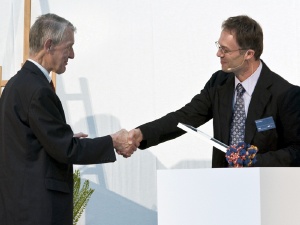Jun 25 2009
Structural biologist Nenad Ban is awarded the Rössler prize, supporting his research with 200,000 Swiss Francs. Over the past few years, Ban and his group have clarified structures of important macromolecular complexes.
 Donator Max Rössler hands Nenad Ban, professor of molecular structural biology at ETH Zurich, the Rössler prize at the ETH Zurich Foundation’s “Thanksgiving” event. (Image: Oliver Bartenschlager/ETH Zurich)
Donator Max Rössler hands Nenad Ban, professor of molecular structural biology at ETH Zurich, the Rössler prize at the ETH Zurich Foundation’s “Thanksgiving” event. (Image: Oliver Bartenschlager/ETH Zurich)
Numerous molecular models line the shelves in Nenad Ban’s office. Most of them are fairly small, maybe the size of a fist. Below these, however, a barrel shaped and fairly colourful one stands out from the rest. Ban picks it up carefully and turns it in his hand. It is a model of the fatty acid synthase, a large multi-enzyme, responsible for the synthesis of fatty acids in cells. The model itself was ‘printed’ by a 3D printer, used by architects to print their models. Layer by layer, the printer deposits a polymer powder, which is hardened with glue where necessary; the rest remains powdery. “At the end, there is a heap of dust, out of which we uncover the molecular model in the same way archaeologists excavate their findings”, says Ban.
No structural models without SLS
However, years of research are necessary before a structure of an important cellular complex can be determined, particularly in the case of large assemblies such as the fatty acid synthase. The ETH professor emphasises that with a molecular weight of 2.5 Mega Daltons, it is one of the largest enzymatic complexes in a cell. Determining structures of such giants is very laborious and complicated not only because of computational challenges but also because these molecules are very flexible and heterogeneous, which makes it very difficult to create good crystals. The macromolecular crystals are then exposed to X-rays at a synchrotron such as the Swiss Light Source (SLS) and the diffraction patterns that the researchers measure are used to determine the exact positions of all atoms that form the molecule. “Our links to the SLS with their excellent macromolecular crystallography beamlines are critical for keeping us at the forefront of structural biology”, acknowledges Ban.
The fruits of a successful phase
Ban and his group have determined, over the past few years, not only the structure of the fatty acid synthase, but also structures of several ribosomal complexes. Ribosomes are the machines in a cell that synthesize proteins out of amino acids based on genetic information of the organism. In recognition of his research the ETH professor has now been awarded the first ever Max Rössler prize from ETH, an award worth 200,000 Swiss Francs. He can use the funds to pursue research in any scientific field he chooses. Ban emphasises that this prize is an award for the whole group. ”We have had a very successful phase over the past few years”, he says. In his view, this is unusual in crystallographic research where success is never guaranteed, but ETH grants the kind of long-term support necessary to be able to carry out demanding research projects.
Scientific Background
The 43 year old was born in Zagreb, Croatia, and has been working at ETH since 2000, first as an assistant professor and, since February 2008, as professor ordinarius of molecular structural biology. As the son of a chemistry professor and a biology professor, he studied molecular biology at the University of Zagreb. He completed his doctoral thesis at the University of California in Riverside, followed by a postdoc in biophysics at Yale University, where he solved the structure of the large ribosomal subunit. This was also where he met his wife, who is also now conducting research at ETH.
The work on structures of macromolecules is basic research, according to Ban. However, the structural information is critical for better understanding of how these molecules work. Structural studies can also be interesting for pharmaceutical industry allowing development of novel drugs that bind and block or disable essential cellular components, such as ribosomes or fatty acid synthases, of various pathogens.
Rössler prize is possible due to a generous donation
The Rössler prize is being awarded this year for the first time. The prize was made possible by last year’s donation of 10m Swiss Francs from Max Rössler and the “Max Rössler Empiris Fund” to the ETH Zurich Foundation. The capital will be used to offer targeted support for extraordinary strategic projects and talents. These will be selected by ETH and recommended to the awarding body of the Foundation. For ETH alumni and former mathematics lecturer Max Rössler, who is also making his expertise in asset management available to the ETH Zurich Foundation, a high quality of education is extremely important: “Switzerland is relying on well trained and innovative engineers, mathematicians and scientists more than ever. With my donation, I want to do something to inspire and support creative talents.”
Thanksgiving – a big thank you to donators
The Max Rössler prize was awarded for the first time on Tuesday evening at the “Thanksgiving” event in the new ETH Zurich geosciences museum focusTerra. The name of this event is also its purpose: ETH Zurich and the ETH Zurich Foundation invite donators and thank them for their contributions. In future, the prize is to be awarded annually. Businesses, people and foundations can offer targeted support to teaching and research at ETH Zurich via the ETH Zurich Foundation.